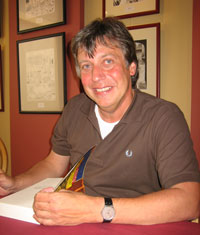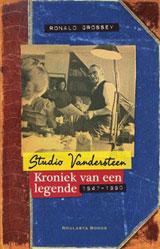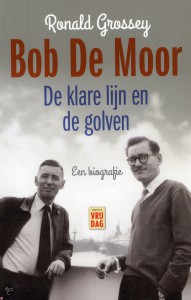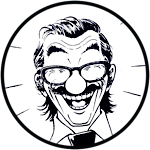
A while ago we had an interview with Ronald Grossey, author of the book “Bob De Moor. De klare lijn en de golven; een biografie”. Grossey isn’t exactly what you can call a new bee in the world of comics. Ronald Grossey (born in Antwerp in 1956) is a flemish author and publisher. In 1979 he founded his own publishing company Exa, which in 1987 would merge with Rudy Vanschoonbeek‘ Dedalus. Between 1995 and 2000 he worked as a comic editor for Standaard Uitgeverij in Antwerp. He also wrote several articles for the magazines Humo, Knack, Robbedoes, Kuifje and was also chief editor for the Suske & Wiske weekly. Next to this he wrote several comic scenarios and books touching the comic world.

A book that many flemish readers will know is his now sold out book 2007’s “Studio Vandersteen, kroniek van een legende 1947-1990” which was published by Roularta Books. It handles the life and work of Willy Vandersteen and is actually a must have in order to understand Vandersteen properly.
So it was just a matter of time before he would also touch that other big flemish comic author Bob De Moor. In 2013 “Bob de Moor. De klare lijn en de golven” was published by Vrijdag.
We talked with Ronald Grossey and to keep it easy for you we also referred here and there to the pages in the book. If you haven’t ordered this book yet, do so now, it’s available right here. A French version is coming up, we’ll inform you via our newsletter when it’s ready for ordering.
BDM: I personally found that you took quite some time jumps by switching every time between the Tintin magazine period and the life and career of Bob De Moor, at times it worked a bit disorientating for me.

RG: I didn’t only want to highlight the life of Bob De Moor but also the (professional) world around him. To understand the importance of Bob De Moor you also need to (get to) know that world. That meant that I sometimes had to sketch that world before I could write about Bob De Moor: Hergé, the weekly Kuifje/Tintin, Belvision… Apart from the first chapter I wanted to work as chronologically as possible, but more importantly when it was about the lives of other people I wanted to complete those phases in their lives per chapter.
BDM: The French speaking market seems a lot bigger than the Dutch speaking market for such a book. Why did you go for Dutch?
RG: It was just a practical issue, a Dutch speaking publisher showed interest. There is a French version coming out though. More info on that later.
BDM: When you compare both bios which you wrote about Bob De Moor and Willy Vandersteen, it is very clear how different they both were character wise. I suspect that all the friction that amassed over all those years eventually exploded when Bob De Moor got the ‘njet’ to complete “l’Alph-Art” after all. Do you think he could have completed it correctly given enough time?
RG: That’s correct, it has indeed something to do with the characters of both men. A Willy Vandersteen or a Hergé would have ‘exploded’ long before.But Bob De Moor was simply a much easier going person. It’s a tricky question if he would have completed “l’Alph-Art” in a good way.He had Tintin in his fingers, that was obvious, but would he have had enough to work with knowing the limited sketches, en writings by Hergé to create a strong story?
BDM: On a side-note, it’s my guess that if Willy Vandersteen would have stayed with the Kuifje/Tintin magazine that we would have had a lot more pearls like we can find in the blue series. Is, according to you, the final result positive as far as Vandersteen is concerned?
RG: One of my most important conclusion when writing the Studio Vandersteen book was that Vandersteen often compared himself and his situation with that of Hergé, even in his last interviews. It was about the choice of going for quantity or quality. But in the end it’s clear why Vandersteen chose for his very own career. If we have to be happy about that choice? Vandersteen was a true storyteller who weekly was busy with several stories. Hergé from his side liked to fiddle on his scenarios. Each his own style huh?
BDM: Now it seems that there are plans for a possible new album by 2052. Knowing that, shouldn’t they have given him the green light? Why now and not back then (when everything was still perfectly possible)?
RG: Times they are changing. Back then it was key to keep Hergé’s graphical heritage intact. The why now and not back then should be answered by Moulinsart.
BDM: What was exactly the problem Pierre Sterckx and Benoit Peeters had with Bob de Moor?
RG: Of course that is a question for them, but from what they have said over the years I can conclude that they considered Bob De Moor to be less good graphically speaking compared to Hergé.
BDM: Let’s go back in time. Do you have any idea as why Bob de Moor had his first drawing published in the Rexist “Les hommes au travail” in 1942? De Moor was part of the Zazou mouvement which was against the occupier. Or could it have been his hunger for action by the Britisch? I talked with the family De Moor about this and they have no idea either.
RG: That is actually for me maybe the most important unanswered question. I’ve been looking for possible connections, a teacher? A family member? Because indeed, why would a young boy from Mortsel, who barely spoke French back then and who flirted with the Zazous bother to get in touch with an extreme-right wing Brussels based magazine. Maybe it was just a coincidence? Because there weren’t so many publication opportunities back then, maybe those students just wanted to have a prank and sent drawings to all the magazines, maybe it was his discontentment with the allies not arriving like his ex-girlfriend Gilbert Ghesquiere said.
BDM: At a certain point I thought that Jacques Van Melkebeke was maybe linked to Bob De Moor even before he went to the Studio Hergé.
RG: The earliest link I know is that the first Barelli was based on a scenario by Jacques Van Melkebeke, and I also heard that he would have hinted the first steps for the second Barelli album.
BDM: His ex-girlfriend Gilbert Ghesquiere, when Bob De Moor was 17, describes him as being rather ‘moody’. It’s the only time that this quality appears, was it reality or can it be linked to a rather coloured memory of madame Ghesquere? By the way, how on earth did you get to know about her existence?
RG: She explained it as being due to the impatience which is typical for the youth, and I can perfectly understand that. Once De Moor had found his ‘place’, a certain ‘rest’ would come over him and he would keep that for the rest of his life. So how did I get in touch with madame Ghesquere? For the Belgian weekly Knack I had made an interview with Johan and Stefaan De Moor, and she wrote me a card. The card didn’t have any telephone number mentioned but there was an address and since I live in the neighbourhood I just went to that address and rang the bell, hoping someone would answer the door. We arranged a meeting and of course I found it extraordinary that I could talk to such a crown witness.
BDM: There is little info concerning the youth of Bob De Moor, he rarely wanted to speak about it. Is it the circumstances (he lived in his parents’ pub) in which he had to live which caused this or was there something else?
RG: According to Gilberte he didn’t have a very optimal relation with his parents, and his own kids have confirmed that the life above a pub didn’t really appeal to him. It’s indeed very remarkable that he hasn’t told a lot about his youth in the many interviews he has done over the years.
BDM: Let’s jump to his time at the Studio Hergé. Jacques Martin often referred to Bob De Moor as being an excellent decor artist. Is this correct?
RG: Although De Moor always has said that he only drew the decors, I assume that depending on the period, his input became/was bigger. it’s clear to me though that the combination of Hergé and decors weren’t really a great match. And he must have been very glad with an assistant like De Moor. It’s also clear that De Moor did way more than just tracing the pencil sketches by Hergé.
BDM: On February 7th, 2010 the auction house Kahn-Dumousset put up a testpage up for sale drawn by Johan De Moor for the reprisal of the Blacke and Mortimer series.
RG: Yes, that’s correct, Johan De Moor was at a certain point in the running to take over the series.
BDM: Contractually Bob De Moor had to deliver the Mortimer vs. Mortimer album on December 31th 1989, if he not he had to pay a fine per day things were delayed. In the end he only delivered the final page in Februari 1990. Did he even have to pay the fine?
RG: As far as I could trace back, he didn’t pay a fine. After all Bob De Moor was very well befriended with the publisher and I think that in the end everybody was happy that that album finally was completed.
BDM: From all the stories published on the Tintin magazine, you really get the impression that it was a very hostile place to work at. How did Bob De Moor position himself in that atmosphere?
RG: In the beginning it were just friends working together, but when more and more comic authors joined, the competition war arrived. De Moor was very diplomatic, so everybody felt at ease with him. I never heard a bad word from him, so I presume he felt very comfortable there.
BDM: Ego tripping is not something unusual on the cmic world, but it seems De Moor wasn’t really interested by that either.
RG: Indeed, he had respect for young artists, and that’s linked with his character.
BDM: If you read all the interviews, there a constant returning idolatry for Hergé. Was it still healthy at the end? I presume that a backlash was just unavoidable, especially when you read the comments by Bob De Moor after he got the njet to complete “l’Alph-Art”. On page 356 the description you wrote there of Bob De Moor is not all that glorious, as if he was very naive.
RG: I don’t know if it was blind idolatry, I just think he had a huge amount of respect and could place himself very well in the work situation which Hergé offered him. It was a comfort zone he lost when Hergé died. Hence why his uncertainty, fed by the rumormill around “l’Alph-Art”. Character wise De Moor simply wasn’t a leader figure like Leblanc once said. Or as his wife would say: “Bob was just a guy who want to draw.”
BDM: On page 315 you write that De Moor noted that there was a question of ‘contestation of original drawings’. What was the exact meaning behind this sentence?
RG: I found that note back in the archives. I couldn’t find out about which drawings he talked here. But according to me it’s about who was the owner of those originals and not the artistic contact.
BDM: On page 319 you talk about recover drawings from Nieke. Who was that Nieke?
RG: Nieke is Nieke Soethoudt, publisher and together with her husband the owner of the publisher De Dageraad. The drawings he referred too are the originals used by De Dageraad for the reissues of “De Leeuw van Vlaanderen” and the “Snoe en Snolleke” series.
BDM: On page 258 you write that Bob De Moor wanted to handle certain gags and pages differently in “Tintin & The Picaros”, but that he stopped insisting on it because the album would be finished even later then. Any idea what these pages and gags were?
RG: No, but it sure is one of the very few times where De Moor criticised the work of Hergé.
BDM: Thanks for the chat!
You can order the book right now on Bol.com.
